Abstract
Heterodera guangdongensis n. sp. is described from bamboo (Phyllostachys pubescens Mazel) based on morphology and molecular analyses of rRNA D2D3 expansion domains of large subunit (LSU D2D3) and internal transcribed spacer (ITS) sequences. This new species can be classified in the Cyperi group. Cysts are characterized by a prominent, ambifenestrate vulval cone with weak underbridge, a vulva-anus distance of 28.9–35.9 μm and a vulval slit of 31.1–41.0 μm, but without bullae. Females are characterized by a 25.1–27.6 μm stylet with rounded knobs sloping slightly posteriorly. Males are characterized by a 21.5–23.0 μm stylet with knobs slightly projecting or flat anteriorly, lateral field with four lines, and a 22.0–26.0 μm spicule with bifurcate tip. Second-stage juveniles are characterized by a 19.3–21.3 stylet with slightly projecting or anteriorly flattened knobs, lateral field with three lines, a 41.7–61.3 μm tail with finely rounded terminus and hyaline portion forming 43.0–57.1% of the tail length. Molecular analyses show that the species has unique D2D3 and ITS rRNA sequences and RFLP-ITS-rRNA profiles.

